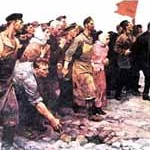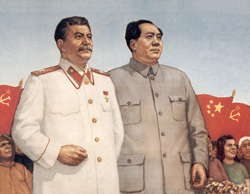1. LECTURE: Wednesday, January 19
Introduction. I have constructed this course around four questions: 1) Why was world communism appealing? 2) What caused it to become deformed? 3) Why did it last as long as it did? And, 4) why did it fail? To set the stage for these questions, I will introduce two factors that recurrently arise in the study of communism. These factors are the sometimes complementary, sometimes contradictory roles of leadership and institutions. I will also argue that we should study world communism as a process of development, and not as a fixed and immutable identity. This is an important point because it helps us to understand why not all communist regimes ended up looking the same.
2. DISCUSSION SECTION: Friday, January 21
Read both of the articles below to prepare for this discussion section and to respond to your writing assignment. Cohen and “Z” (the historian Martin Malia) take fundamentally different approaches to the study of world communism. Cohen emphasizes human volition, Malia emphasizes structure. As we shall see throughout this course, the two approaches have significantly different implications. At this point, you only need to concentrate on identifying and internalizing the authors’ arguments. We will address the events behind their positions as we move through the 20th century.
Writing assignment: “Why is Cohen’s critique of the Whig interpretation of history relevant to his debate with ‘Z’?” Please write one paragraph (no more!) for your discussion section on Friday. Turn in the assignment to your TA at that time. Since you will examine the two articles closely, be sure to bring your Reader to this section.
-
Stephen F. Cohen, Rethinking the Soviet Experience, ch. 2: Course Reader
-
“Z” (Martin Malia), “To the Stalin Mausoleum,” Daedalus, 119, 1 (1990): only sections I, II, XI, and XII. Course Reader
3. LECTURE: Monday, January 24
The Foundations: Karl Marx and Friedrich Engels’ Communist Manifesto. The Manifesto offers a convenient and concise outline of Marx’s prophecies about world revolution. Importantly, it is also an ambiguous guide to many of the issues that arise over the course of communist history.
-
Karl Marx and Friedrich Engels, The Communist Manifesto (1848). Only sections 1,2, and 4.
-
For a useful study guide on reading the Manifesto, see HERE
4. LECTURE: Wednesday, January 26
Contending Visions of Socialism and Revolution. In this lecture, I will describe two different conceptions of how the communist revolution was supposed to take  place in turn-of-the-century Britain and Germany. These two documents represent important examples about these conceptions. As you read them, imagine that you are living at the cusp of 20th century Europe: What key issues are Bernstein and Luxemberg raising? If you were interested in revolutionary change, why would these perspectives matter to you?
place in turn-of-the-century Britain and Germany. These two documents represent important examples about these conceptions. As you read them, imagine that you are living at the cusp of 20th century Europe: What key issues are Bernstein and Luxemberg raising? If you were interested in revolutionary change, why would these perspectives matter to you?
-
Eduard Bernstein, Evolutionary Socialism (1899), Preface: HERE
-
Rosa Luxemburg, “Reform or Revolution” (1900). Read only the Introduction: HERE
5. DISCUSSION SECTION: Friday, January 28
Writing assignment: “If, according to Marx, the bourgeoisie’s “fall and the victory of the proletariat are equally inevitable,” then why do you need Communists to “point out and bring to the front the common interests of the movement as a whole”? Turn in this paragraph to your TA on Friday.
The goal of this section is to discuss not only what Marx says about world revolution but also how his remarks could be differently interpreted by successive generations of communists. Don’t forget to bring the Communist Manifesto to your discussion section.
6. LECTURE: Monday, January 31
The World Revolution’s unexpected Setting: Backward Russia. None of the early communists, not even Marx or Engels, expected their revolution to take place in Russia. In fact, Marx was adamant that it would not. Why did the revolution occur first in Russia? One must consider the setting of the revolution in order to understand two essential facts about world communism: 1) why the Russian context was better suited than the modern industrial world to live up to Marx’s prophecies; and 2) why this setting provided the fuel for full-blown conflicts among communist movements for generations to come.
-
Robert Tucker, “Marxism and Modernization,” in your Course Reader.
-
William Rosenberg and Marilyn Young, Transforming Russia and China, pp. 3-34.
7. LECTURE CANCELLED: Wednesday, February 2
Notre Dame is Shut Down for the “Exceedingly Lame Blizzard Of 2011” (ELBOW 2011)
8. DISCUSSION SECTION: Friday, February 4
What are the similarities between Lenin’s What is to be Done? and his State and Revolution? What are the differences? Are these differences necessarily contradictory? Is the first pragmatic, and the second merely propaganda? Or are they both central to his theory of the transitions between capitalism and communism?
One paragraph writing assignment: “In which of these two works do we find the real Lenin? Or do they both present us with the real Lenin?”
9. LECTURE: Monday, February 7
Lenin asks and answers the Question: “What is to be Done?” Lenin provides the foundational definition of the Communist party. But 15 years later, he gives us some potentially contradictory suggestions about the utopian society to come. More than Marx, Lenin becomes the icon of world revolution.
suggestions about the utopian society to come. More than Marx, Lenin becomes the icon of world revolution.
-
Vladimir I. Lenin, What is to be Done? (1901-1902): Excerpts in the Course Reader. If you like, you can read the entire tract HERE.
-
Vladimir I. Lenin, State and Revolution (1917): Only the excerpts in the Course Reader. If you like, you can read the entire tract HERE.
-
Rosenberg and Young, Transforming Russia and China, pp. 35-71.
-
On Lenin.
- Sergei Eisenstein’s depiction of the Revolution: You Tube
10. LECTURE: Wednesday, February 9
The Battles over the Russian Path to World Revolution. The idea of a proletarian world revolution seemed straightforward to the early Marxists. But when the revolution came to Russia, a single, backward country, instead of the West, the event unleashed a debate among Soviet leaders about the implications of this experience. Not only did they passionately disagree about this question but the conclusions they drew about building socialism within their country were profoundly different as well.
-
Rosenberg and Young, Transforming Russia and China, 120-35, 147-66.
-
“Z,” “Stalin Mausoleum,” sections II-V. Course Reader
-
Nikolai Bukharin, “The New Economic Policy of Soviet Russia,” July 8, 1921: HERE (Print)
-
J. V. Stalin, “The October Revolution and the Tactics of the Russian Communists” (excerpt), Dec. 17, 1924: HERE (Print)
-
J. V. Stalin, “Bukharin’s Group and the Right Deviation in our Party,” January 1928: HERE (Print)
11. DISCUSSION SECTION: Friday, February 11
Paragraph assignment: “Was the Stalinist victory over the Bukharinist approach to building socialism inevitable, or at least extremely likely?”
I realize that your knowledge about Soviet history is limited. As a result, I do not expect you to be able to address all the nuances of this question. You should simply base your response on your primary readings and the knowledge you have gained from secondary sources, such as Cohen and “Z.”
The goal of this section is to discuss the issue of alternatives to Stalinism and identify the kinds of evidence that you would need to prove that such alternatives existed. If Bukharin had been victorious in his struggle with Stalin, would he have been willing and able to implement a more benign version of Marxism-Leninism? Or was there some characteristic that Lenin introduced into Soviet socialism that would have driven Bukharin and other like-minded revolutionaries in Stalin’s direction? This section is designed to develop your analytical skills in assessing complex arguments. Thus, be sure to print the articles for this week by Stalin (“The October Revolution,” “Bukharin’s Group”) and Bukharin(“The New Economic Policy of Soviet Russia”) and bring them to this section. Also, bring your Lenin readings from the Course Reader.
12. LECTURE: Monday, February 14
Making Revolution from above versus Struggling from Below? In this lecture, I present two different paths to revolution and suggest why these paths have had significant consequences for world communism.
communism.
-
Rosenberg and Young, Transforming Russia and China, pp. 72-119.
-
Robert Tucker, “Marxism and Communist Revolutions”: HERE (Print)
-
Mao Zedong, “Report on an Investigation of the Peasant Movement in Hunan,” March 1927: HERE (Print)
EVENING FILM: “Interrogation“
First Showing of “Interrogation,” Tuesday, February 15 at 7:00 pm in 114 Pasquerilla Center
Second Showing of “Interrogation,” Wednesday, February 16 at 7:00 pm in 107 Pasquerilla Center
The use of electronic devices of any kind, including laptops, cell phones, video cameras, and personal digital devices, is prohibited in my classroom!
Top of Page · Founders · Competitors · Defenders · Reformers · Losers